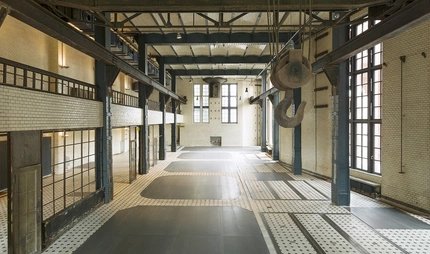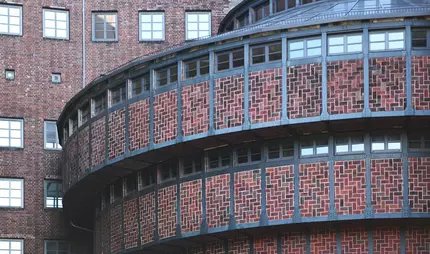
Kraftwerk Berlin
The turbines may be out of action, but life's pumping here now!
A very special energy attracts people from all over the world to Kraftwerk Berlin in the former Mitte cogeneration plant: it is a unique event location and one of the most prominent clubs in the world.
In the 1960s, the Kraftwerk Berlin in the former Mitte cogeneration plant was not yet a trendy industrial design venue, but a real industrial building. It is easy to guess that the huge turbine hall generates energy for large parts of the eastern city centre. Because right next door today is the successor building: the Berlin-Mitte combined heat and power plant.
After reunification, there was initially no use for the power plant. Until cultural manager Dimitri Hegemann finally discovered the charm and potential of this location and moved in with the legendary Club Tresor. But Kraftwerk Berlin has long been more than just a club venue. Exhibitions and trade fairs, shows and international concerts have been taking place in this unique atmosphere since 2010.
Heat and energy for East Berlin
It is probably no coincidence that the Berlin power plant was built in the years 1961-1964 of all years. The GDR government had just erected the Berlin Wall to prevent its own citizens from fleeing to the West.
The city was completely divided and the centre of the separated eastern part of the city needed its own energy supply. So a huge new power station sprang up on Köpenicker Strasse - a cogeneration plant, to be precise. A combined heat and power plant is a special source of power because it generates heat and electricity at the same time in a combined process. This process is particularly suitable for a densely populated city like Berlin, as it works efficiently and conserves resources. The huge turbines of the Berlin power plant initially ran on heavy fuel oil, and since 1982 also on natural gas, supplying flats on Alexanderplatz as well as the Charité hospital and the GDR State Council building.
New paths after reunification
However, after reunification, the power plant's technology became obsolete. Between 1994 and 1996, the new operator Vattenfall therefore had a successor built right next door on the site to the north. It supplies 600,000 households and is also connected to the Klingenberg combined heat and power plant to the east. The new plant impresses with a new level of efficiency: the fuel utilisation rate is 90 percent.
However, the new building designed by Kassel-based architect Jochem Jourdan is not only the most modern combined heat and power plant in Europe at the time, but also a deliberate accent in Berlin's cityscape. Not only the two chimneys contribute to this, but also the high-calibre art on the building. These include:
- The heated benches by sculptor Ayse Erkmen,
which utilise the waste heat from the combined heat and power plant - The pop art-influenced wall frieze by painter Franz Ackermann in the foyer of the administration building
- The glass pavilion by conceptual artist Dan Graham
- The clinker brick wall by architect Per Kirkeby
- The mural by object artist Thomas Bayrle made of 12.000 fired tiles with a quote from the Old Testament
Jourdan has visibly and clearly separated the different functional areas of his building. The dark clinker bricks with which the architect clad the new power station are a tribute to the Berlin industrial architect Hans Heinrich Müller. As head of the construction department at Berliner Elektrizitätswerk Aktiengesellschaft (BEWAG), Müller designed functional buildings with individual aesthetic requirements in the 1920s, for which clinker brick was the decisive building block:
- Abspannwerk Kottbusser Ufer
- Abspannwerk Bergmannstraße
- Abspannwerk Leibniz in Charlottenburg, today's MetaHaus
- E-Werk (Formerly. Abspannwerk Buchhändlerhof)
- Umspannwerk Humboldt
- Abspannwerk Scharnhorst

The techno temple Tresor moves in
The old Berlin power station has had no function since its closure in 1997 and has lain derelict for years. It was not until 2007 that this fate changed decisively when cultural manager Dimitri Hegemann discovered the location for himself and Berlins club culture.
Hegemann was looking for a new home for his legendary techno club Tresor. This Berlin institution owes its name to the Tresor room of the former Wertheim department stores' on Leipziger Straße. DJs have been spinning techno here since 1991, earlier than in any other club in the capital. The Tresor soon became world-famous, with the addition of Tresor events with DJ Sven Väth at the Love Parade and its own record label.
But in 2005, the Tresor could no longer hold its own. The once shunned area by the Berlin Wall is now a highly attractive city centre area. The Tresor's lease expires and a new office building takes the place of the old Wertheim department stores'.
For two years, Tresor parties are held provisionally at other locations, but on 25 May 2007, the club moves into the Kraftwerk Berlin. Incidentally, the organisers saved some of the original lockers and installed them in the new location.

The development into an event location
But today, Kraftwerk Berlin is much more than just the new home of Tresor. Hegemann had the entire building extensively extended and remodelled. After a few years, the industrial monument has 8,000 square metres of exhibition and event space. There is space for up to 2,600 visitors. Another impressive feature is the mobile crane bridge, which enables spectacular installations.
The exhibition "Realstadt. Wishes as Reality", the gigantic turbine hall will be given a new purpose in 2010. A year later, scenes from the film portrait "Joschka and Mr Fischer" about the former Green Foreign Minister were shot at Kraftwerk Berlin. Today, Kraftwerk Berlin is home to the Berlin Atonal sound art festival and numerous bands have also discovered the special atmosphere of the venue for their performances - from Max Herre to Einstürzende Neubauten.
Our tips for Kraftwerk Berlin
For a well-earned break, there are numerous places to eat and drink nearby, for example around Oranienplatz. Shopping is tempting in the opposite direction: Alexanderplatz with its diverse range of shops is just on the other side of the Spree.
For further sights, you can reach the Künstlerhaus Bethanien ten minutes to the south. Other aspects of Berlin's exciting history await you directly on the banks of the Spree: the Märkisches Museum with its exhibition on the city's history, the Nikolaikirche as the oldest preserved church in the centre of Berlin and the historic harbour on Fischerinsel with its collection of various historic ships.
Practical information from visitBerlin
The best way to get to Kraftwerk Berlin is to take U-Bahn line 8 to the Heinrich-Heine-Straße stop or the Stadtbahn to Jannowitzbrücke S-Bahn station. From there it is only a few metres to Kraftwerk Berlin. To explore the city, we recommend the Berlin Welcome Card for public transport.
Information for cyclists
The Kraftwerk Berlin is located on the cycle route: Tour: Warm light and cool beer
More cycle routes can be found in our tour suggestions


